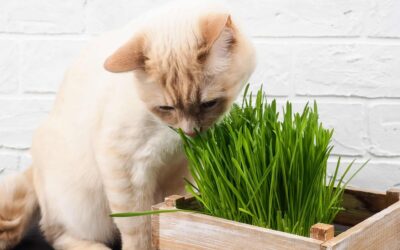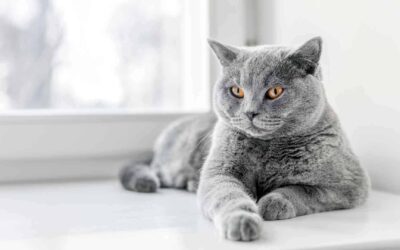Halloween Stress Relief for Cats

Preparing your home for a cat-friendly Halloween doesn’t just ensure your feline’s comfort; it also helps reduce their stress during the holiday’s excitement. Cats can become overstimulated and anxious with the constant opening and closing of doors, unfamiliar costumes, and sudden noises. That’s why it’s essential to take steps to create a safe and calming environment for your cat.
Here are some helpful tips to make this Halloween a more enjoyable and stress-free experience for both you and your furry friend.
Prepare Your Home for a Cat-Friendly Halloween
Secure Windows and Doors
The first concern you should address is ensuring your cat is inside your house. Since trick-or-treaters require constant opening and closing of doors, which can create opportunities for your cat to slip out unnoticed, ensure that all windows and doors are securely shut down to prevent your cat from escaping.
Keep Your Cat Calm and Reassured, Rather than Adding to Their Anxiety and Discomfort by DressingThem Up
“Halloween is already quite a stressful time for some pets, with excited children, familiar people looking different in costumes and masks, and lots of unfamiliar people coming to the door too. It’s always best to try to keep pets calm and reassured rather than adding to their anxiety and discomfort by dressing them up.”
Set up a quiet, cozy area where your cat can retreat if they feel overwhelmed. This could be a spare room or a designated corner of your home. Providing comfortable bedding, water, food, and a litter box in that particular space will help create a safe environment for your cat.
Avoid Using Real Candles and Store Candies in Cat-Proof Containers
Halloween decorations can pose risks to your cat. Instead of using real candles in jack-o’-lanterns opt for battery-operated alternatives to eliminate fire hazards. Keep decorations like fake cobwebs out of reach, as cats can become entangled. Store Halloween candy in secure, cat-proof containers to prevent accidental ingestion of harmful substances like chocolate or xylitol.
Prevent Overstimulation in Your Feline Friend
The constant ringing of doorbells, excited chatter of trick-or-treaters, and spooky decorations can overwhelm our feline friends, leading to sensory overload.
As the Cat Care Society explained: “Overstimulation (sometimes shortened to “overstim”) is when cats experience sensory overload from too much petting, caused by a painful nerve reaction, stress or built-up frustration. It has nothing to do with a cat’s temperament but an actual physiological response to touch. Basically, their nervous system goes into overdrive, and they feel significant discomfort.”
“The best way to help cats with overstimulation is by providing daily enrichment, scheduled play/hunt sessions, and even trying to clicker train your cat.’’
Here are some additional ways to help reduce noise and visual stimulation for your cat.
Use White Noise or Calming Music to Help Reduce Your Cat’s Stress
New research in the Journal of Feline Medicine and Surgery highlights the stress-reducing effects of music on cats, focusing on their preferred tempo and vocal range.
Music can have a calming effect on your cat and help reduce anxiety. Before Halloween, try different sounds to see how your cat reacts. Some cats may prefer white noise, while others might find classical music soothing. There is even specially designed music for cats, incorporating purring sounds and other feline-friendly tones.
Limit Exposure to Halloween Activities
Consider moving Halloween activities outside to minimize disruptions inside your home. This approach allows your cat to relax indoors while you greet trick-or-treaters outside. If possible, avoid using motion-activated decorations or those that make sudden noises, as these can startle your cat. Stick to safe and calming decorations to create a more peaceful environment for your feline friend.
Consider Window Coverings
Using appropriate window coverings can help reduce visual stimulation for your cat. Roller shades or room-darkening shades can effectively block the sights of Halloween activities outside. These window treatments are durable and can withstand some wear and tear from curious cats. Additionally, they can be adjusted to allow your cat to peek outside when they want to while still providing security.
Plan for Emergencies and Special Situations
Update Microchip Information
Constantly opening and closing doors may result in a missing or lost pet, causing stress and anxiety for you as a pet owner. A microchip provides a permanent form of identification, which is essential for reuniting with your pet if they accidentally escape. Take a moment to check and update your contact details in the microchip company’s online database.
Remember, a microchip is only effective if the information linked to it is up to date.
Have a Pet First-Aid Kit Ready
Prepare a pet first-aid kit for Halloween and keep it easily accessible. Include items such as conforming bandages, a digital thermometer, and skin-cleaning wipes. Both cats and humans can use these supplies in case of minor injuries.
Know Emergency Vet Locations
Familiarize yourself with the nearest emergency veterinary clinics before Halloween. Keep their contact information and addresses readily available. In case your cat experiences any health issues or accidents during the festivities, you’ll know where to go for immediate care can make a significant difference.
How Can Pet Insurance Help You if Your Cat Needs an Emergency Treatment?
Pet insurance can be a valuable tool in managing the costs of treating a cat’s veterinary expenses. By having a pet insurance policy in place, you can have peace of mind knowing that you can provide medical care for your furry companion without worrying about the financial burden. Pet insurance can help cover the costs of veterinary consultations, diagnostic tests, medications, and even specialized treatments if required.
Reimbursement
This method is the most common for pet insurance companies. You pay out of pocket for the veterinarian bill, and then the insurance company reimburses you for what’s covered under the insurance plan. The steps look like this.
- You pay the vet bill after your cat’s visit.
- You fill out the pet insurance claim form.
- Submit the claim form and other required documentation to the insurer.
- After the claim is approved, you will be reimbursed for eligible expenses.
What Does Odie Pet Insurance Cover?
Pet insurance covers various veterinary expenses, providing financial protection and peace of mind for pet owners. Here are the details of the coverage options offered by Odie Pet Insurance:
Illness & Injury Plan
The Illness & Injury Plan is an all-inclusive insurance plan designed to cover a wide range of medical needs for your pet. This plan includes comprehensive coverage for various illnesses, injuries, and veterinary services. Some of the covered items include:
- Veterinary exams and consultations
- Diagnostics (e.g., X-rays, lab tests)
- Prescribed medications
- Surgeries and hospitalization
- Rehabilitation, acupuncture, or chiropractic treatments
- Medically necessary supplies
- Euthanasia and cremation
The Wellness Plan
The Wellness Plan is a monthly membership that focuses on preventive care and covers routine veterinary services.
-
- Provides reimbursements for routine care items such as wellness visits (exams and vaccines), testing and parasite prevention, dental cleanings and at-home dental care, vitamins, supplements, and more.
- Through Odie’s partnership with Petivity, a leader in smart pet products and proactive care, Wellness Plan members can also receive reimbursements for Petivity devices and health kits, as well as eligible Purina food and supplements.
- Total reimbursement up to $700 per year.




